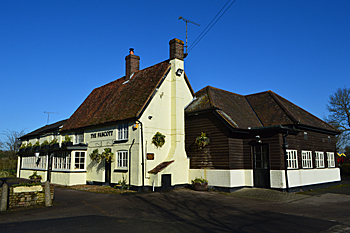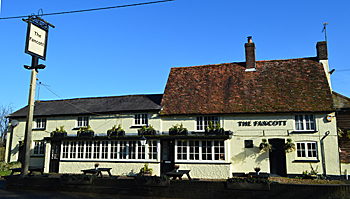The Fancott Public House

The Fancott March 2016
The Fancott Public House: Luton Road, Fancott
An early mention of the Fancott can be found in an auction notice published in the Luton Times and Advertiser, Saturday 23rd April 1870. The lots were to be sold by G. Greene on the 13th May 1870 by direction of the Trustees under the will of Thomas Cleaver, late owner.
Lot 1 (of 3) was described as consisting of “The Beerhouse, three Cottages, pightle of Sward and Premises, situate at Fancote, as now occupied by Thomas Wilson, William Read, and others (being under tenants) containing together two acres, more or less.” However, the earliest mention of the Fancott in a record held at Bedfordshire Archives is in the countywide licensing register of 1876 when it was an unnamed beerhouse. The owner was John Allen of Ampthill, who leased it to Henry Kingsley of Kimpton [Hertfordshire], thus the licensee, Thomas Wilson was a sub-tenant. By the time of the countywide directory nothing had changed; the beerhouse still had no name.
By 1913 the beerhouse, together with three other cottages, was in the hands of London brewers Fuller, Smith and Turner of Chiswick and in this year they conveyed them to Amy Marlow of Toddington, spinster, for £275 [ref: HN10/370/Marlow2]. The Rating and Valuation Act 1925 specified that every building and piece of land in the country was to be assessed to determine its rateable value. The valuer visiting the Fancott, surprisingly, made no mention of its being licensed [ref: DV1/A9/12 and 12a]. He visited on 4th September 1926 and found that today's Fancott was divided into two tenements. The south-east portion was owned by Ernest Wilson junior and occupied by Ernest Willson senior; it wsas called Fancote Cottage; there was no rent. Accommodation comprised a reception room, a kitchen, two bedrooms a timber and corrugated iron coal barn and a common earth closet. This was clearly the licensed portion. The valuer commented "House old".
The north-west portion and outbuildings to the south-west were also owned by Wilson junior but occupied by G Bowers whose rent was £13 per annum for two reception rooms, a kitchen, a scullery, four bedrooms, two brick and tiled barns and two brick and tiled earth closets. The valuer commented: "House old" and "Was two cottages".
At some point Ernest Wilson sold the business to Ernest Edward Nelson of Kentish Town [London] and in 1937 he sold it to London brewers Whitbread (which sold all its public houses in 2002). The Fancott Arms, as it was called by then, became a fully licensed public house on 8th April 1949 [ref: PSW3/32].
The building was listed by the former Department of Environment in September 1980 as Grade II, of special interest. It dates from the 17th century and comprises two storeys beneath an old clay tiled. The building is covered in roughcast, probably over a timber-framed structure. There is a lower extension on the left-hand side. At the time of writing [2016] the Fancott, as it is now known, remains a public house, owned by Wallman Pubs, which also owns The Crown in Henlow.
Licencees: note that this is not a complete list and that dates in italics are not necessarily beginning or end dates, merely the first/last date which can be confirmed from sources such as directories and deeds:
1876-1894: Thomas Wilson: convicted 26th September 1894 of being open during prohibited hours, fined 10/- with 10/- costs;
1894-1907: Elizabeth Wilson;
1907-1917: Edward Wilson;
1917-1937: Ernest Wilson;
1937-1954: John William Stringer;
1954: Raymond Thorpe;
1954-1955: Sarah Jane Stringer;
1955: William George Cotton and Samuel Richard;
1955-1958: Ernest Godfrey;
1958-1959: Mary Edith Godfrey;
1959: Philip Holles;
1985: Terence Edward Taylor;
1985: Monty David Penny;
1990: Lee Mark Baxter.

The Fancott seen from the road March 2016
List of sources at Bedfordshire Archives:
- HN10/370/Marlow2: draft conveyance: 1913;
- RDLP2/104: additions to the Fancott Arms: 1929;
- PSW3/32: renewal of licence: 1949.
- Luton Times and Advertiser,